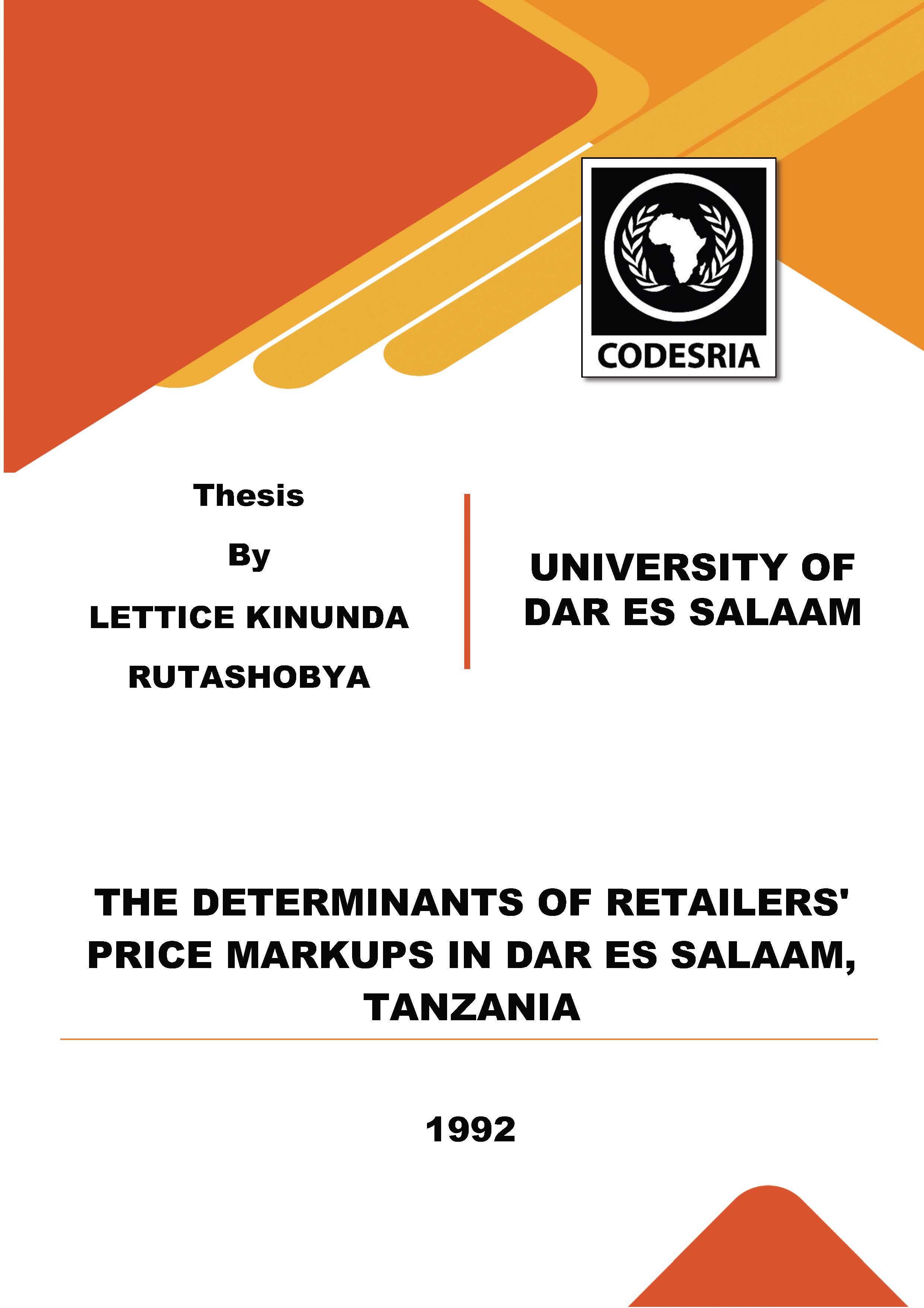THE DETERMINANTS OF RETAILERS' PRICE MARKUPS IN DAR ES SALAAM, TANZANIA
Keywords:
PRICE, DAR ES SALAAM, TANZANIASynopsis
This research examined the pricing behaviour of retailers in Dares Salaam, Tanzania. To this· end, variability of retail margins and factors that determine margin practices were investigated: A theoretical model relating retail margins to four explanatory variables was developed. Accordingly, the study had the following major objectives:
( 1) to investigate markup differences among retailers' product groups (primary).
(2) to determine the effects of merchandise cost, merchandise rate of stock turn, location of retail outlet.and population size on retail margins,
(3) to determine whether margin variances of product categories were different from those of individual product items.
On the basis of these objectives and the available literature evidence the following conceptual hypotheses were advanced:
1. Retail margins are not uniform for the various product groups;
2. Markups are inversely related to merchandise cost;
3. Markups are inversely related to merchandise rate of stock turn.
4. Markups are directly related to location of retail outlet, that is the farther the retail outlet is from the city centre the higher the mark-up.
5. Markups are inversely related to population size of a store's market area.
6. Markup differences among product categories are greater than margin differences among product types.
The research design that was used to test these hypotheses involved a cross-sectional survey. Despite its short comings it was the only feasible alternative at the time of the study. After defining the hypotheses operationally, statistical investigation methods that included the one-way analysis of variance, t-tests and multiple regression analysis were used. To improve the scope of variable relationships mathematical transformations using both linear and non-linear methods were carried out. Following these statistical investigations some contributions and conclusions to the understanding of retail margin variations and its "causal" relationships were made. The findings are both consistent and inconsistent with the existing literature which were undertaken in economically advanced countries. These findings were that:
1. like in past studies done elsewhere, retail margins in Tanzania vary widely among product groups as well as among product items. This finding is consistent with the theoretical bases and expectations that firms will practice price discrimination to maximize profit,
2. the relative effect of the variables on retail margins is different. It appears that in Tanzania retail margins are influenced more by merchandise costs than merchandise rate df stock-turn, location of retail outlet and population size. The effect of turnover rate on margins is less dominant than the literature in economically advanced countries suggests. The main conclusion arising out of this finding is that pricing strategies and policies are not at any point universally optimal. A retailer seeks to maximize profits by employing a pricing strategy that will suit existing market conditions and product characteristics.
3. Although the factors differently influence retail margins, the findings generally appear to support the theoretical expectations in the sense that the hypothesized directions are generally supported except with respect to the variable "location". This means that some costly and high turnover merchandise carry low markups and some less costly and low turnover merchandise carry high markups. Also, retail outlets in high population market area carry low markups.
4. The relationship between retail margins and the independent variables merchandise cost, merchandise turnover rate, location of retail outlet, and population size is not 1 in ear. This implies that studies that do not take into account the various
forms of functional relationships may give misleading findings.
5. The interaction between retail margins and the explanatory variables merchandise cost, merchandise turnover rate, location of retail outlet and population size is not overwhelming in the laundry soap, furniture and grocery categories. This implies that factors other than these should be explored in future research. The relevant factors should take into consideration market conditions and product characteristics.
Downloads
References
Ghosh, A.N. and R. Shoemaker: "A Comparison of Market Share Models and Estimation Procedures". Journal of Marketing Research. Vol. 21 pp 202-10.
Gould, J. and W. Kolb: A Dictionary of the Social Sciences. Tavistock, UNESCO, Tavistock Publication, 1964.
Gujarati, D. : Basic Econometrics, International Student Edition, 1978.
Hall, M.: The Small Unit in the Distributive Trades, Committee of Inquiry on Small firms, U.K. Research Report No. 8 HMSO, 1971.
Hall, M. and Knapp, G. : Efficiency and Gross Margins. Reprinted in K.A. Tucker and B.S. Jamey eds.
Hamburg, M.: Statistical Analysis for Decision Making. 4th Edition. New York: Harcourt Brace Jovanovich,
Inc., 1987.
Hawkins, H.C.G.: Wholesale and Retail Trade in Tanganyika. A Study of Distribution in East Africa. New
York. Fredrich A. Praeger, 1965.
Heathfield, D.: Topics in Applied Macroeconomics, MacMillan Press Ltd., Basingstoke, 1976.
Hebden, J.: Statistics for Economists. Oxford. Philip Allan, 1981.






